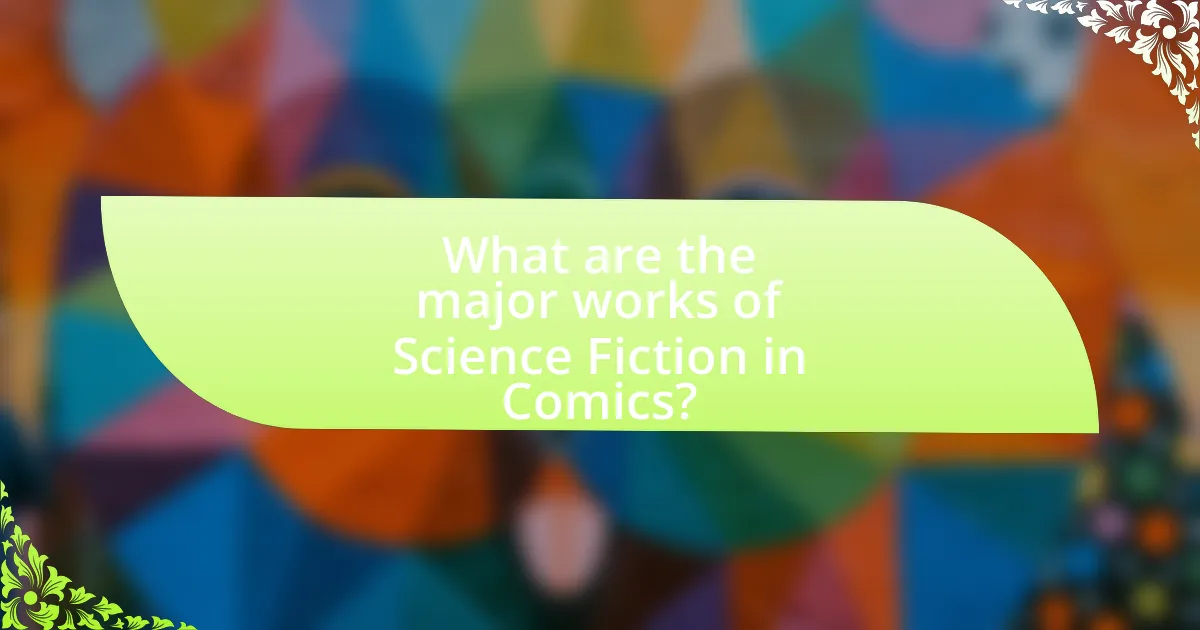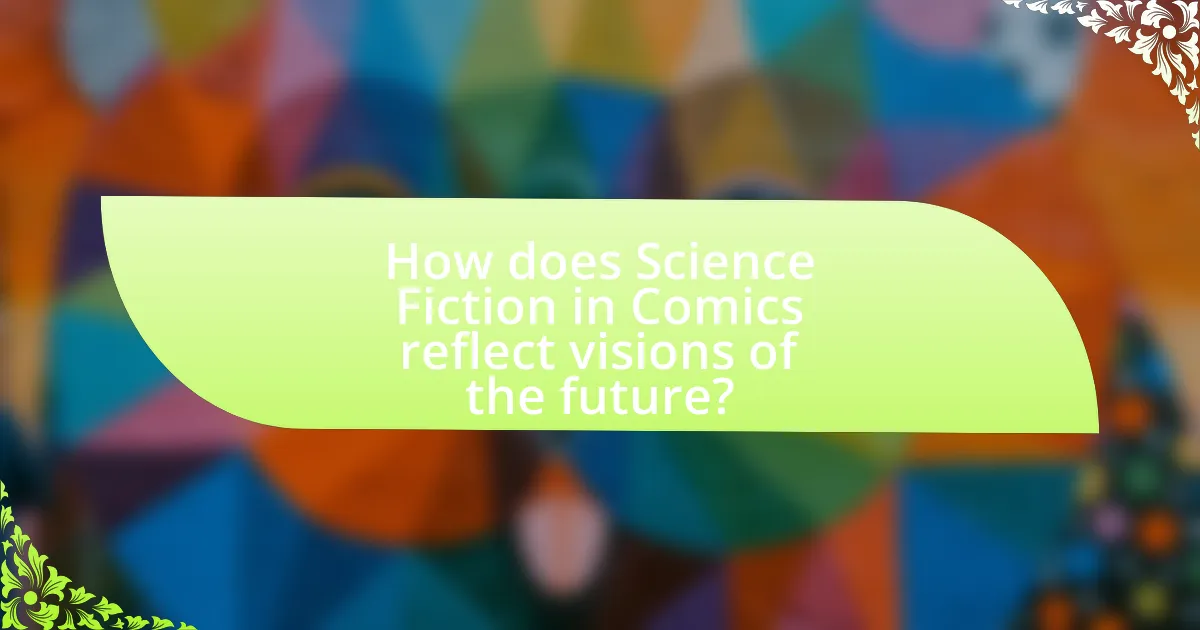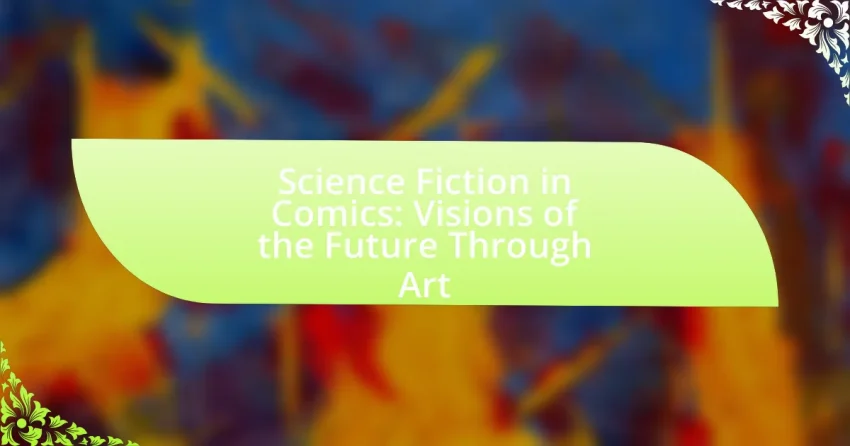Science fiction in comics is a genre that explores futuristic concepts, advanced technology, and speculative scenarios through visual storytelling. This article examines the influence of science fiction on the comic book medium, highlighting key themes such as advanced technology, dystopian futures, and societal reflection. It discusses major works and iconic titles that define the genre, the contributions of notable creators, and how visual elements enhance narratives. Additionally, the article addresses the societal issues presented in futuristic narratives and the lessons about humanity and technology that can be drawn from these comics, emphasizing their role in inspiring creativity and innovation.

What is Science Fiction in Comics?
Science fiction in comics is a genre that explores futuristic concepts, advanced technology, space exploration, and speculative scenarios through visual storytelling. This genre often features imaginative worlds, alien species, and complex narratives that challenge the boundaries of reality. Notable examples include works like “Watchmen” by Alan Moore and Dave Gibbons, which delves into alternate histories and moral dilemmas, and “Saga” by Brian K. Vaughan and Fiona Staples, which combines fantasy and science fiction elements to address themes of family and conflict. These comics not only entertain but also provoke thought about societal issues, making science fiction a significant and influential genre within the comic medium.
How has Science Fiction influenced the comic book genre?
Science fiction has significantly influenced the comic book genre by introducing imaginative concepts, advanced technology, and futuristic settings that expand narrative possibilities. Iconic comic book characters and storylines, such as those found in “The Flash” and “Green Lantern,” often draw from science fiction themes like time travel and intergalactic exploration. The Golden Age of Comics in the 1930s and 1940s saw the emergence of superheroes whose powers were often rooted in scientific phenomena, reflecting the era’s fascination with science and technology. Additionally, works like “Watchmen” and “The Sandman” incorporate complex science fiction elements, showcasing how the genre can address philosophical and societal issues. This blending of science fiction with comic book storytelling has led to a rich tapestry of narratives that continue to evolve, demonstrating the enduring impact of science fiction on the comic book medium.
What are the key themes of Science Fiction in comics?
The key themes of Science Fiction in comics include exploration of advanced technology, dystopian futures, alien life, and the impact of science on society. These themes are prevalent as they allow creators to examine human nature and societal issues through speculative narratives. For instance, comics like “Watchmen” and “Transmetropolitan” delve into dystopian societies shaped by technology and political corruption, while titles such as “Saga” and “The Green Lantern” explore the complexities of alien civilizations and intergalactic conflicts. These thematic elements not only entertain but also provoke thought about the future implications of current scientific advancements and ethical dilemmas.
How do visual elements enhance Science Fiction narratives in comics?
Visual elements significantly enhance Science Fiction narratives in comics by providing immediate visual context and emotional resonance that words alone cannot convey. The use of imaginative artwork, such as futuristic landscapes, alien species, and advanced technology, allows readers to visualize complex concepts and settings, making the narrative more immersive. For instance, the detailed illustrations in works like “Saga” by Brian K. Vaughan and Fiona Staples create a vivid universe that complements the storytelling, engaging readers on multiple sensory levels. Additionally, visual elements can convey tone and mood through color palettes and artistic styles, further enriching the narrative experience. This synergy between visuals and text is crucial in Science Fiction, where abstract ideas often require visual representation to be fully understood and appreciated.
Why is Science Fiction important in the context of comics?
Science fiction is important in the context of comics because it serves as a vehicle for exploring complex themes such as technology, society, and the human condition. Comics like “Watchmen” and “The Sandman” utilize science fiction elements to challenge readers’ perceptions of reality and morality, illustrating how speculative scenarios can reflect contemporary issues. This genre allows creators to push boundaries and envision alternative futures, fostering critical thinking and imagination among audiences. The incorporation of science fiction in comics has historically led to significant cultural conversations, as seen in works that address topics like dystopia and identity, thereby reinforcing its relevance and impact in the medium.
What role does Science Fiction play in societal reflection through comics?
Science fiction in comics serves as a critical lens for societal reflection by exploring contemporary issues through imaginative narratives. This genre allows creators to address themes such as technology, identity, and social justice, often projecting current societal anxieties into futuristic or alternative settings. For instance, works like “Watchmen” and “V for Vendetta” critique political systems and individual freedoms, reflecting real-world concerns about governance and personal autonomy. Additionally, comics like “Black Panther” and “Ms. Marvel” highlight issues of race and representation, showcasing diverse perspectives and fostering discussions about inclusion. These narratives not only entertain but also provoke thought, encouraging readers to engage with and question their societal norms and values.
How does Science Fiction in comics challenge cultural norms?
Science fiction in comics challenges cultural norms by presenting alternative realities that question societal values and beliefs. Through imaginative storytelling, comics often depict futuristic societies where traditional gender roles, racial dynamics, and political structures are subverted or redefined. For instance, works like “Ms. Marvel” feature a Muslim-American teenage superhero, which disrupts stereotypes and promotes diversity. Additionally, titles such as “Watchmen” critique power structures and moral ambiguity, encouraging readers to reconsider their views on authority and ethics. These narratives not only entertain but also provoke critical thought about the status quo, making science fiction in comics a powerful medium for cultural critique and transformation.

What are the major works of Science Fiction in Comics?
Major works of science fiction in comics include “Watchmen” by Alan Moore and Dave Gibbons, “The Sandman” by Neil Gaiman, “Saga” by Brian K. Vaughan and Fiona Staples, and “Transmetropolitan” by Warren Ellis and Darick Robertson. “Watchmen,” published in 1986-1987, is renowned for its complex narrative and deconstruction of superhero tropes. “The Sandman,” released from 1989 to 1996, blends mythology and horror with a rich storytelling style. “Saga,” which began in 2012, is celebrated for its innovative blend of fantasy and science fiction elements. “Transmetropolitan,” published from 1997 to 2002, critiques society through a cyberpunk lens. These works have significantly influenced the genre and are recognized for their artistic and narrative depth.
Which iconic titles define the Science Fiction comic genre?
Iconic titles that define the Science Fiction comic genre include “Watchmen,” “The Sandman,” “Transmetropolitan,” and “Saga.” “Watchmen,” created by Alan Moore and Dave Gibbons, revolutionized the superhero genre with its complex narrative and moral ambiguity, while “The Sandman,” by Neil Gaiman, blends mythology and horror with science fiction elements. “Transmetropolitan,” written by Warren Ellis, offers a satirical view of a dystopian future, and “Saga,” by Brian K. Vaughan and Fiona Staples, combines fantasy and science fiction in a space opera narrative. Each of these titles has significantly influenced the genre, showcasing innovative storytelling and artistic styles.
What are the characteristics of these iconic Science Fiction comics?
Iconic Science Fiction comics are characterized by imaginative storytelling, futuristic settings, and exploration of advanced technology and alien life. These comics often feature complex characters who navigate moral dilemmas and societal issues, reflecting contemporary concerns through speculative narratives. For instance, works like “Watchmen” and “The Sandman” delve into themes of power, identity, and existentialism, showcasing how science fiction can serve as a mirror to human experience. Additionally, the visual style in these comics frequently employs vibrant colors and dynamic artwork to enhance the otherworldly atmosphere, as seen in titles like “Saga” and “Transmetropolitan.”
How have these titles influenced subsequent works in the genre?
These titles have significantly influenced subsequent works in the science fiction comic genre by establishing foundational themes, narrative structures, and artistic styles. For instance, works like “Watchmen” and “The Dark Knight Returns” introduced complex characters and moral ambiguity, which have become staples in later comics, inspiring creators to explore deeper psychological and societal issues. Additionally, the visual storytelling techniques employed in these titles, such as non-linear narratives and innovative panel layouts, have set new standards for artistic expression in the genre. This influence is evident in modern series like “Saga” and “The Wicked + The Divine,” which continue to push the boundaries of storytelling and art in science fiction comics.
Who are the key creators in Science Fiction comics?
Key creators in Science Fiction comics include Jack Kirby, known for his groundbreaking work on titles like “The Fourth World” and “New Gods,” which introduced cosmic themes and complex characters. Another significant figure is Moebius, whose unique art style and storytelling in works like “The Airtight Garage” and “Blueberry” have influenced the genre globally. Additionally, Alan Moore, recognized for “Watchmen” and “V for Vendetta,” has shaped narrative complexity in Science Fiction comics. These creators have contributed to the evolution of the genre, establishing foundational themes and artistic styles that continue to resonate in contemporary works.
What contributions have notable writers made to the genre?
Notable writers have significantly shaped the science fiction genre in comics by introducing innovative narratives, complex characters, and thought-provoking themes. For instance, writers like Alan Moore and Neil Gaiman have pushed the boundaries of storytelling, with Moore’s “Watchmen” exploring moral ambiguity and societal issues, while Gaiman’s “Sandman” blends mythology with modernity, redefining character development in the genre. Additionally, Frank Miller’s “The Dark Knight Returns” has influenced the portrayal of dystopian futures and anti-heroes, impacting both comic book storytelling and broader cultural perceptions of heroism. These contributions have not only enriched the genre but also established a framework for future writers to explore deeper philosophical questions through the medium of comics.
How have artists shaped the visual storytelling of Science Fiction in comics?
Artists have significantly shaped the visual storytelling of Science Fiction in comics by creating imaginative worlds and characters that convey complex narratives. Through their unique styles and techniques, artists like Jack Kirby and Moebius have established iconic visual languages that enhance the thematic depth of science fiction stories. For instance, Kirby’s dynamic compositions and bold colors in titles such as “The New Gods” have influenced the portrayal of cosmic themes, while Moebius’s intricate line work and surreal landscapes in “The Airtight Garage” have expanded the boundaries of visual imagination in the genre. These artistic contributions not only define the aesthetic of science fiction comics but also engage readers by visually representing abstract concepts like time travel, alien civilizations, and dystopian futures, thereby enriching the overall storytelling experience.

How does Science Fiction in Comics reflect visions of the future?
Science fiction in comics reflects visions of the future by exploring advanced technologies, societal changes, and potential human evolution. These narratives often depict futuristic settings that challenge contemporary norms, showcasing innovations like space travel, artificial intelligence, and genetic engineering. For instance, comics such as “Watchmen” and “Transmetropolitan” critique political and social structures, projecting possible futures shaped by current issues. The portrayal of dystopian societies in works like “V for Vendetta” serves as a cautionary tale, warning against totalitarianism and loss of individual freedoms. This genre not only entertains but also provokes thought about the trajectory of humanity, making it a powerful medium for envisioning future possibilities.
What predictions about the future are presented in Science Fiction comics?
Science fiction comics predict various future scenarios, including advanced technology, space exploration, and societal changes. For instance, comics like “Watchmen” and “Transmetropolitan” explore dystopian futures shaped by political corruption and technological advancements. Additionally, works such as “The Jetsons” envision a future with flying cars and robotic assistance, reflecting mid-20th-century optimism about technology. These predictions often serve as cautionary tales or utopian visions, illustrating the potential consequences of current societal trends.
How do these predictions compare to real-world technological advancements?
Predictions in science fiction comics often align closely with real-world technological advancements, reflecting societal aspirations and fears. For instance, the depiction of advanced robotics in comics like “Iron Man” parallels the rapid development of AI and robotics in industries today, such as Boston Dynamics’ humanoid robots. Furthermore, the concept of virtual reality, prominently featured in comics like “Ready Player One,” has materialized through technologies like Oculus Rift and HTC Vive, showcasing immersive experiences that were once purely speculative. These examples illustrate that many technological advancements have roots in the imaginative visions presented in comics, demonstrating a tangible connection between fiction and reality.
What societal issues are addressed through futuristic narratives in comics?
Futuristic narratives in comics address various societal issues, including technology’s impact on humanity, environmental degradation, social inequality, and the consequences of authoritarian governance. For instance, comics like “Transmetropolitan” explore the effects of media saturation and political corruption, highlighting the dangers of unchecked power. Additionally, works such as “The Fifth Element” and “Snowpiercer” illustrate environmental collapse and class disparity, emphasizing the urgent need for social justice and sustainable practices. These narratives serve as cautionary tales, reflecting contemporary concerns and prompting discussions about potential futures shaped by current societal trends.
How do different styles of art impact the portrayal of future visions?
Different styles of art significantly impact the portrayal of future visions by shaping the aesthetic, emotional, and conceptual frameworks through which these visions are communicated. For instance, the sleek, minimalist designs often found in modern digital art can evoke a sense of advanced technology and utopian futures, while the chaotic and exaggerated forms in expressionist art may reflect dystopian themes and societal anxieties. Historical examples include the retro-futuristic style of 1950s comics, which envisioned a future filled with optimism and space exploration, contrasting sharply with the darker, more fragmented representations seen in contemporary graphic novels that address themes of climate change and societal collapse. These stylistic choices not only influence the viewer’s perception but also guide the narrative direction of the stories being told, reinforcing the emotional resonance and thematic depth of the future visions presented.
What are the various artistic styles used in Science Fiction comics?
Various artistic styles used in Science Fiction comics include cyberpunk, retro-futurism, surrealism, and space opera aesthetics. Cyberpunk often features high-tech, low-life themes with neon colors and urban landscapes, exemplified in works like “Blade Runner” adaptations. Retro-futurism combines vintage design elements with futuristic concepts, as seen in comics like “The Jetsons.” Surrealism introduces dream-like imagery and bizarre scenarios, often challenging perceptions of reality, evident in titles like “The Sandman.” Space opera aesthetics emphasize grand, epic narratives with detailed alien worlds and advanced technology, showcased in series like “Star Wars” comics. Each style contributes uniquely to the genre, enhancing storytelling through visual representation.
How does art style influence reader perception of futuristic themes?
Art style significantly influences reader perception of futuristic themes by shaping the visual narrative and emotional response to the depicted world. For instance, a sleek, minimalist art style can evoke feelings of advanced technology and utopian ideals, while a chaotic, detailed style may suggest dystopian realities or societal collapse. Research indicates that visual elements, such as color palettes and line work, directly affect how readers interpret the themes presented; studies show that bright colors often correlate with optimism, while darker tones can imply danger or uncertainty. Thus, the chosen art style not only enhances the storytelling but also guides the audience’s emotional engagement with the futuristic concepts being explored.
What can readers learn from Science Fiction in Comics?
Readers can learn about societal issues, technological advancements, and human behavior through Science Fiction in Comics. These narratives often explore themes such as dystopia, identity, and the consequences of innovation, reflecting contemporary concerns and future possibilities. For instance, works like “Watchmen” by Alan Moore and Dave Gibbons critique power structures and morality, while “Transmetropolitan” by Warren Ellis addresses media influence and political corruption. Such comics serve as a lens to examine real-world challenges, encouraging critical thinking and imagination about the future.
How can Science Fiction comics inspire creativity and innovation?
Science Fiction comics inspire creativity and innovation by presenting imaginative worlds and futuristic concepts that challenge conventional thinking. These comics often explore advanced technologies, alternative societies, and complex moral dilemmas, encouraging readers to envision possibilities beyond current limitations. For instance, works like “Watchmen” and “Transmetropolitan” have sparked discussions about ethics in technology and governance, prompting creators and innovators to think critically about real-world applications. Additionally, the visual storytelling in Science Fiction comics stimulates artistic expression, leading to new styles and techniques in both art and design. This combination of narrative and visual innovation fosters a culture of creativity that can lead to groundbreaking ideas in various fields, including technology, art, and social sciences.
What lessons about humanity and technology can be drawn from these narratives?
Narratives in science fiction comics reveal that humanity’s relationship with technology is complex and multifaceted. These stories often illustrate the potential for technology to enhance human capabilities, as seen in characters who utilize advanced tools for problem-solving and creativity. However, they also caution against over-reliance on technology, highlighting themes of alienation, loss of identity, and ethical dilemmas, such as the consequences of artificial intelligence and surveillance. For instance, works like “Watchmen” and “Transmetropolitan” explore the societal impacts of technological advancements, emphasizing the need for ethical considerations in innovation. Thus, these narratives teach that while technology can empower humanity, it also necessitates responsibility and critical reflection on its implications.
